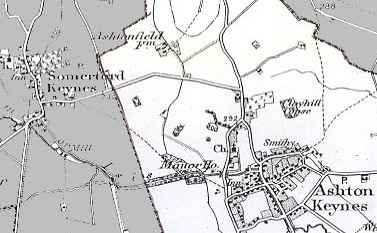
John Plumbe snr. farmed the Ashton Field farm, in Ashton Keynes, Wiltshire from the early 1850'suntil his death in 1871, after which it was farmed by his son, also John Plumbe, until John jnr. sold up and moved to Manor Farm, Ablington, Gloucester in 1915. Many of the records of this farm during this period are held in the Gloucestershire Record Office (Reference Code: D4128).
 |
|
|
The farm had a interesting footnote in the 1930's when it was bought by the Bruderhof, a German pacifist religious group that was expelled from Nazi Germany and moved to England in 1936 where they bought the 200-acre Ashton Fields farm (described as being derelict) and established a commune known there named the Cotswold Bruderhof that at one time housed more than 350 people, including some English followers. The group developed the farm, renovating buildings and cultivating the land; adding 103 adjoining acres in 1937 and running a successful mixed farm & large market garden. They also set up craft and publishing ventures. In 1940, pressured by anti-German feeling in England during the war that threatened to intern its German members, the Bruderhof sold up and moved to Paraguay, and eventually to the United States.
Heinrich Arnold was an elder of the Bruderhof movement. Peter Mommsen
describes Ashton Fields in his book Homage
to a Broken Man; The Life of J. Heinrich Arnold (www.heinricharnold.com,
where the book can be downloaded as a free e-book) or (buy
used)
(Chapter 18)
Ashton Fields Farm looked partly like a dilapidated medieval manor
and partly like a pioneer’s homestead. Coming from the road, Heiner and
Annemarie had driven past endless hedged fields. Next, they passed through
a complex of muddy yards—hen yard, duck yard, stockyard, and piggery—and
mounds of straw and manure untidily interspersed with the rusting farm
machinery. In the middle stood a cluster of rundown buildings, all of stone,
their steep gray roofs tiled with slate. Now Alfred was showing them the
cottage where they were to stay. Heiner noticed broken windows, unhinged
doors, and a fireplace in every room. Annemarie noticed the overgrown gardens,
bright with daffodils and yellow primroses.
Heiner loved the place instantly. Here he could put his Strickhof
training to work. What did it matter that in the barn, they had to stretch
tarpaulins over the cows to protect them from crumbling masonry? For six
weeks, he worked fourteen-hour days to prepare the fields for spring planting,
using an antiquated tractor that took forever to start.
(Chapter 19; July 1938)
In just two years, they had transformed the property into a model
of progressive agriculture. Two hundred people were living off what had
been a family farm. Even the neighbors, always wary of newcomers, admitted
that the cash-strapped Germans had done an amazing job...
Now Ashton Fields was blossoming. Crowds of mostly young guests
swarmed the farm. With the clouds of a new conflict looming over Europe,
veterans of the Great War were calling for peace with an unprecedented
urgency, and tens of thousands were joining a vibrant peace movement. The
more radical among them, dissatisfied with mere activism, were looking
for a whole new mode of living, and new cooperatives and communes were
springing up all over England.
Apart from those who were seriously interested in community living,
busloads of tourists arrived on the weekends at Ashton Fields. Students
and members of the Workers’ Education Association, the Peace Pledge Union,
and the Fellowship of Reconciliation poured in, sometimes hundreds at a
time. So did communists, socialists, agnostics, atheists, and others who
were fed up with the empty promises of “churchianity.”
(Chapter 21; October 1940)
There was so much work to do. Guests continued to flock to the farm,
and every month, dozens announced their intention to stay. The community
had also taken in twenty Jewish refugees from Austria, including three
children, and was searching for patrons who would sponsor more. Thirty
members of a Zionist youth group had come for one year of agricultural
training before traveling on to Palestine to found a kibbutz. Housing had
to be built for all these new residents, and rations stretched. Heiner
was always busy training new field hands. It seemed that every new addition
to the community had come straight from the city, or from the university...Then,
as the bombing raids increased in frequency throughout the summer and suspicion
and fear of foreigners grew, several of the Bruderhof’s neighbors had turned
hostile. Local newspapers regularly printed letters attacking “the German
Peace Community.” Fantastic rumors spread quickly. “The Germans at Ashton
Fields are spying on the airbases,” it was said. “They’re buying fields
for paratroopers to land on! They’re planning to help the invaders!”. The
rumors spread as far as Westminster. The House of Lords discussed billeting
a guard at the Bruderhof, and in the House of Commons a certain Captain
Graham took the floor, demanding to know why the “German Peace Community”
had not yet been interned. He expounded on several local rumors, including
one inspired by a tree house the Ashton Fields schoolchildren had built:
“Is the government aware that they are building observation towers on their
property?”...
Drunken soldiers of the Home Guard arrived one night, searching
farm sheds and dwellings—and ordering a fruit tree to put its hands up
or be shot. Regional newspapers printed calls for a boycott of the community’s
milk and eggs, after which most of the customers vanished. Once two ruffians
were overheard in the local pub planning to set fire to the farm buildings
(their plans were thwarted). “Isn’t it time to leave Britain?” Heiner and
others wondered.
Sources:
If you have any comments, additions or modifications to the information on this page, please feel free to email me.
Created and maintained by: chris@ocotilloroad.com